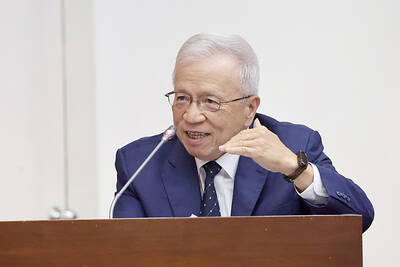Gold has in little more than two months gone from being a favored reflation bet to heading for its worst first quarter in almost four decades.
The change of fortune comes as higher yields dent the appeal of bullion, which offers no interest. At the same time, optimism that the rollout of COVID-19 vaccines would drive a global recovery has pushed investors to switch from the traditional haven to other assets.
Gold’s turnaround has been sharp. After enjoying its best year in a decade, the metal has slumped more than 10 percent this year.
Investor inflows into exchange-traded funds (ETFs), which supported the metal’s surge to a record above US$2,075 an ounce in August last year, have gone into reverse. While inflation expectations are rising, which some investors say should support gold, that is being overshadowed for now by the effects of rising yields.
Holdings in gold-backed ETFs have declined to the lowest since June last year and spot bullion prices down 0.1 percent at US$1,695.13 an ounce on Friday for a third weekly loss.
Gold for April delivery fell US$2.20 to US$1,698.50 an ounce, down 4.3 percent for the week.
Silver for May delivery fell US$0.17 to US$25.29 an ounce, down 8.5 percent, and copper for May delivery rose US$0.10 cents to US$4.08 a pound, down 4.4 percent.
On Friday, the metal touched the lowest in almost nine months after US Federal Reserve Chairman Jerome Powell stopped short of forcefully pushing back against a recent surge in long-term borrowing costs, sending US Treasury yields soaring.
During an appearance in a Wall Street Journal Webinar on Thursday, Powell said the bond market swings “caught my attention.”
He said he is monitoring financial conditions and would be “concerned” by disorderly markets.
“Although inflation is becoming a theme, gold is struggling,” said Robert Jan van Der Mark, a portfolio manager at Aegon NV who sold his gold holdings in late November last year. “The recent move in US yields was also mainly driven by real yields moving up, not really by break-even inflation. That’s not helping gold prices.”
For some, the vaccine breakthroughs in November proved a turning point, with Bank of America Corp dropping its previous bold forecast of US$3,000 for bullion.
Others are playing catch-up. Hedge funds have slashed their long positions to the lowest since May 2019, while banks from Goldman Sachs Group Inc to UBS Group AG are racing to lower their forecasts for the precious metal.
Investor disillusionment with bullion is partly being fueled by the arrival of a new competitor: bitcoin. Those fearing currency debasement now have an alternative asset whose supply is inherently limited, with the digital currency surging this year.
“Some investors are clearly looking at bitcoin and digital assets as a replacement for gold,” Citigroup Inc analyst Aakash Doshi wrote in a note. “There is a material enough overlap of retail and more importantly institutional dollars in these markets.”
Still, it might be premature to write off gold, with signs of a recovery in the physical markets that were particularly hard-hit during the COVID-19 pandemic last year.
Indian jewelry demand is rebounding from a more-than two-decade low, with prices falling below the psychologically important level of 50,000 rupees (US$688) per 10g, which kept buyers away last year.
In China, gold is now trading at a premium to London prices after being cheaper for most of last year, another sign of recovering demand.
“On a longer-term view, we see gold moving higher given supportive trends such as rising incomes in emerging markets boosting physical demand and global annual mined production continuing to decline,” said Evy Hambro, global head of thematic and sector based investing at BlackRock Inc.
Still, that might be some way off, as improving growth prospects mean there is little appetite for the haven asset in the immediate term.
“Higher rates and an improving economy are suppressing gold,” said Plurimi Wealth LLP chief investment officer Patrick Armstrong, who cut his funds’ exposure to the metal by half in November last year. “In our base case, gold won’t do well.”
Additional reporting by AP, with staff writer

JITTERS: Nexperia has a 20 percent market share for chips powering simpler features such as window controls, and changing supply chains could take years European carmakers are looking into ways to scratch components made with parts from China, spooked by deepening geopolitical spats playing out through chipmaker Nexperia BV and Beijing’s export controls on rare earths. To protect operations from trade ructions, several automakers are pushing major suppliers to find permanent alternatives to Chinese semiconductors, people familiar with the matter said. The industry is considering broader changes to its supply chain to adapt to shifting geopolitics, Europe’s main suppliers lobby CLEPA head Matthias Zink said. “We had some indications already — questions like: ‘How can you supply me without this dependency on China?’” Zink, who also

At least US$50 million for the freedom of an Emirati sheikh: That is the king’s ransom paid two weeks ago to militants linked to al-Qaeda who are pushing to topple the Malian government and impose Islamic law. Alongside a crippling fuel blockade, the Group for the Support of Islam and Muslims (JNIM) has made kidnapping wealthy foreigners for a ransom a pillar of its strategy of “economic jihad.” Its goal: Oust the junta, which has struggled to contain Mali’s decade-long insurgency since taking power following back-to-back coups in 2020 and 2021, by scaring away investors and paralyzing the west African country’s economy.

BUST FEARS: While a KMT legislator asked if an AI bubble could affect Taiwan, the DGBAS minister said the sector appears on track to continue growing The local property market has cooled down moderately following a series of credit control measures designed to contain speculation, the central bank said yesterday, while remaining tight-lipped about potential rule relaxations. Lawmakers in a meeting of the legislature’s Finance Committee voiced concerns to central bank officials that the credit control measures have adversely affected the government’s tax income and small and medium-sized property developers, with limited positive effects. Housing prices have been climbing since 2016, even when the central bank imposed its first set of control measures in 2020, Chinese Nationalist Party (KMT) Legislator Lo Ting-wei (羅廷瑋) said. “Since the second half of

AI BOOST: Next year, the cloud and networking product business is expected to remain a key revenue pillar for the company, Hon Hai chairman Young Liu said Manufacturing giant Hon Hai Precision Industry Co (鴻海精密) yesterday posted its best third-quarter profit in the company’s history, backed by strong demand for artificial intelligence (AI) servers. Net profit expanded 17 percent annually to NT$57.67 billion (US$1.86 billion) from NT$44.36 billion, the company said. On a quarterly basis, net profit soared 30 percent from NT$44.36 billion, it said. Hon Hai, which is Apple Inc’s primary iPhone assembler and makes servers powered by Nvidia Corp’s AI accelerators, said earnings per share expanded to NT$4.15 from NT$3.55 a year earlier and NT$3.19 in the second quarter. Gross margin improved to 6.35 percent,